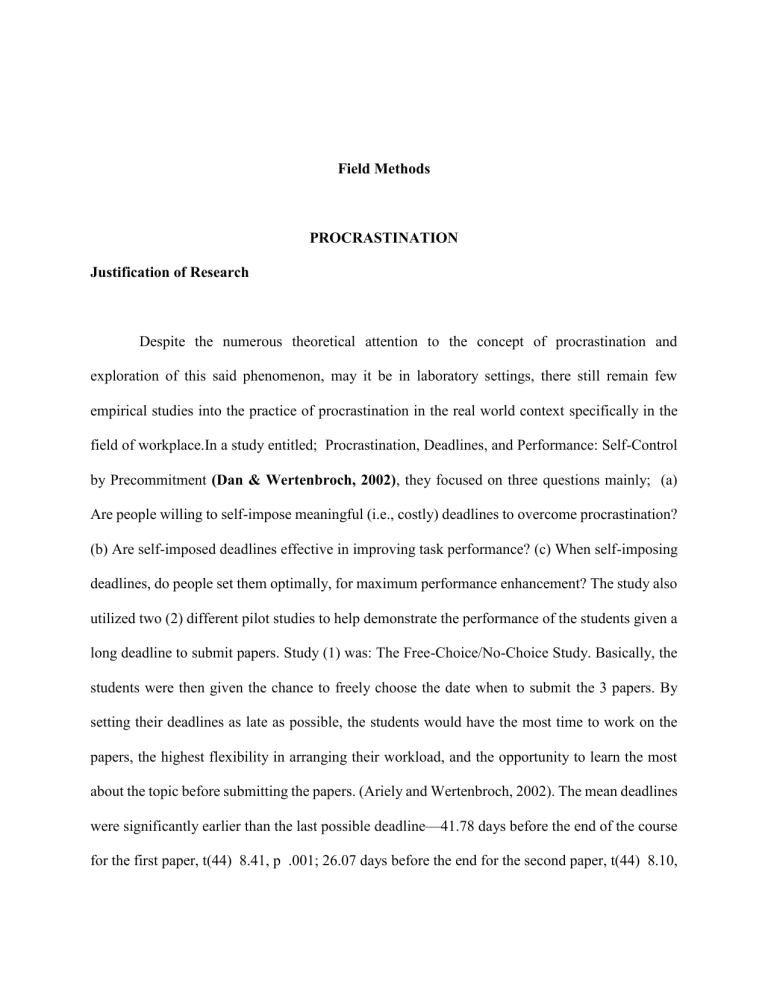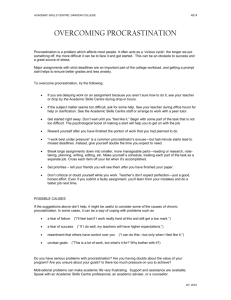
Field Methods PROCRASTINATION Justification of Research Despite the numerous theoretical attention to the concept of procrastination and exploration of this said phenomenon, may it be in laboratory settings, there still remain few empirical studies into the practice of procrastination in the real world context specifically in the field of workplace.In a study entitled; Procrastination, Deadlines, and Performance: Self-Control by Precommitment (Dan & Wertenbroch, 2002), they focused on three questions mainly; (a) Are people willing to self-impose meaningful (i.e., costly) deadlines to overcome procrastination? (b) Are self-imposed deadlines effective in improving task performance? (c) When self-imposing deadlines, do people set them optimally, for maximum performance enhancement? The study also utilized two (2) different pilot studies to help demonstrate the performance of the students given a long deadline to submit papers. Study (1) was: The Free-Choice/No-Choice Study. Basically, the students were then given the chance to freely choose the date when to submit the 3 papers. By setting their deadlines as late as possible, the students would have the most time to work on the papers, the highest flexibility in arranging their workload, and the opportunity to learn the most about the topic before submitting the papers. (Ariely and Wertenbroch, 2002). The mean deadlines were significantly earlier than the last possible deadline—41.78 days before the end of the course for the first paper, t(44) 8.41, p .001; 26.07 days before the end for the second paper, t(44) 8.10, p .001; and 9.84 days before the end for the third paper, t(44) 4.97, p .001. It shows that only 43 deadlines (32%) were set for the final week of class. The majority of the deadlines were set prior to the last lecture. (Ariely and Wertenbroch, 2002). These findings demonstrate individuals' readiness to set self-imposed deadlines as a strategy to combat procrastination, even when such deadlines come with associated costs (addressing our initial inquiry). Despite having the option to select less stringent private deadlines, the students opted for deadlines that demanded greater commitment and carried the potential cost of a grade penalty for tardiness. This suggests a willingness to take the risk of losing grade points in order to employ the self-control mechanism of precommitment. On the other hand, Study (2) was entitled as; The Proofreading Study. With this study, they created three passages with a length of about 10 pages each and inserted about a total of 100 grammatical and spelling errors. In each condition, we clearly explained to the participants that their payoffs would depend on how many errors they detected and on the time of submission of each proofread text. Participants were told that submitting their tasks early was permitted (without increasing their compensation), but that delay in submission would result in a penalty of $1 for each day of delay. In the evenly-spaced-deadlines condition, participants had to submit one of the three texts every 7 days; in the end-deadline condition, they had to submit all three texts at the end of 3 weeks (21 days); and in the self-imposed-deadlines condition, they had to choose their own deadline for each of the three texts within the 3-week window. The results showed that participants in this condition chose to space out their proofreading tasks, F(2, 38) 63.28, p .001, thus showing a preference for self imposing costly deadlines. Results were similar for participants’ delays in submitting their proofreading work (in this case, shorter delays resulted in higher payoffs). Participants’ earnings reflected a combination of error detection and delay and thus showed the same pattern of results. However, the study did not determine the level of self- control of the students but only focused on their performance on meeting the deadline and by their overall output. The possible gap in the study could be limited generalisability of the findings and the focus was mainly on meeting specific deadlines and may not fully represent the diversity of real-world situations of procrastination in the workplace. Additionally, the study assumes that individuals recognize the optimal deadlines for themselves, but this may vary based on the nature of tasks and personal characteristics and may vary person to person. In this case, we will attempt to fill the gaps by exploring the issue of procrastination in the context of the workplace, by assessing or to determine the self-control levels among working professionals to help understand their capacity to regulate their behavior in the workplace setup Research Problem: 1. How often do employees tend to procrastinate at work? 2. What is the relationship between self-control and procrastination among professionals? 3. How does procrastination impact the workplace? 4. How does procrastination impact both individual and organizational productivity? Research Hypothesis: Individuals with higher levels of self-control are less likely to engage in workplace Scope and Limitations This study about the Role of self control in workplace procrastination among working professionals conducted in Phinma Saint Jude College focuses on one of the branches in Dimasalang cor. Don Quijote St., Sampaloc. Metro Manila.. The researchers aim to determine the correlation between employees' levels of self-control and their procrastination at work. To assess or determine the self-control levels among working professionals to help understand their capacity to regulate their behavior in the workplace set up.



